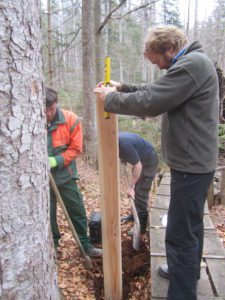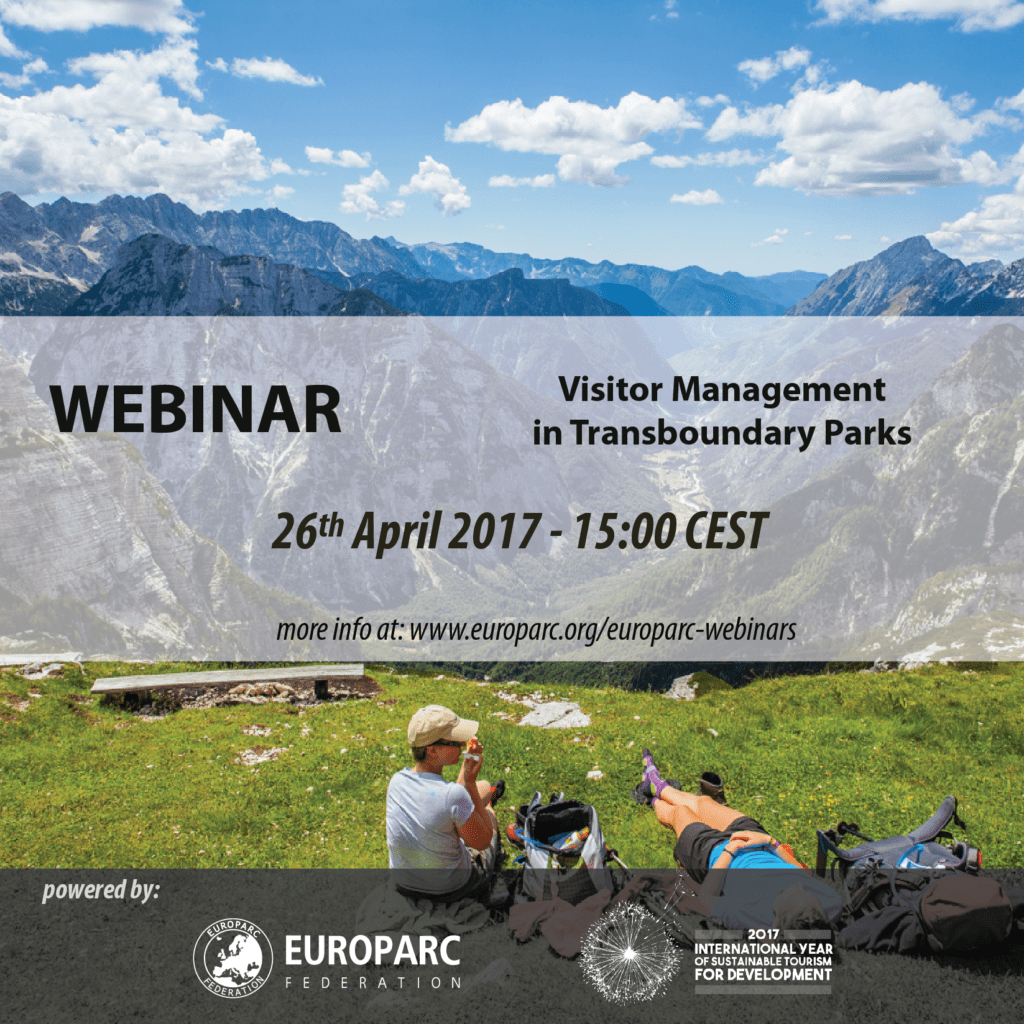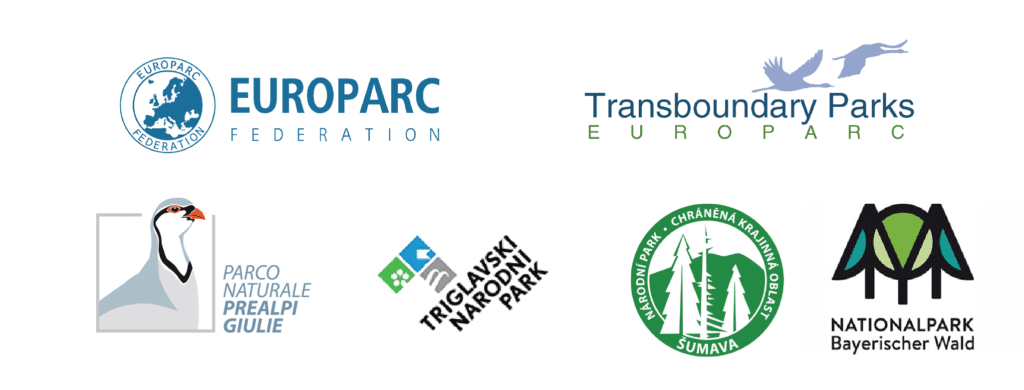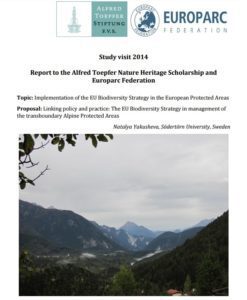Experience exchange with Caucasus – Müritz National Park
participants in front of a lime tree, over 800 years old in the village of Speck © Muritz National Park Archive
On 20th and 21st of April, Müritz National Park received a group of 24 guests from protected areas in Armenia, Azerbaijan, and Georgia. The focus of the meeting was the development of nature tourism, which was studied on the spot in the UNESCO World nature heritage site of Serrahn and in the nature experience center Müritzeum in the city of Waren.
During the visit, the Park shared its experience with the implementation of the European Charter for Sustainable Tourism in Protected Areas, with a special focus on the methodology and the benefits it bring for the Park and its local communities.
Müritz National Park is located in northeastern Germany and has been awarded the Charter in 2011. Currently, the Park is on the way to update the tourism strategy and action plan.
European policies and the role of Protected Areas – Seminar-dialogue with DG Environment
EU flags in front of European Commission © www.esomar.org
Partnerships for biodiversity: European policies and the role of Protected Areas
Seminar-dialogue with DG Environment
On 13th and 14th of June, EUROPARC welcomes members to a special seminar in Brussels. This is a unique opportunity to engage in dialogue with the European Commission-DG Environment about the role of Protected Areas across a range of important topics.
This seminar will, through bringing case studies from the field to the policymakers directly, improve the dialogue between the European Commission and Protected Areas (PAs). The event will also raise awareness of Protected Areas managers in EU policies and funding. The exchange of information will also increase the effectiveness and visibility of the PAs’ contribution to the achievement of European policy goals in nature protection and sustainable development.
During the seminar, Protected Areas managers and European Commission Officers will explore and discuss together different topics related to Natura 2000 and Protected Areas, such as the management of habitats and species, green infrastructures, transboundary collaboration, Natura 2000 communication, sustainable agriculture and fishery, sustainable tourism, nature and health, and youth involvement. Throughout we will emphasise the role of partnerships between Protected Areas authorities with local communities and the business sector.
Registrations
Places are limited, but we look forward to welcoming as many members as possible to Brussels. Participation is free of charge but registration is mandatory. This event is specially addressed to EUROPARC members directly working with Protected Areas and European Commission officers.
Please register here
Agenda Download
Tuesday 13.06.2017
EUROPARC Federation office in Brussels – Boulevard L. Boulevard Louis Schmidt 64, 1040 Brussels
15:00 – 17:00 Introduction of the event
EUROPARC Federation Office
- Registration of participants
- Welcome from EUROPARC Federation
- Presentation of the EUROPARC activities in Brussels
- Presentation of the seminar’s aims and participants expectations
18:00 – 20:00 Networking reception
Wednesday 14.06.2017
European Commission – DG Environment, Avenue de Beaulieu 5, 1160 Brussels
9:00 – 9:15 Welcome
- Registration of participants
- Welcome from DG Environment
- Introduction of the Seminar’s aims and agenda by EUROPARC
9:15 – 11:00 Protected areas and the management of habitats and species
- Short introduction by EUROPARC
- The experience of periurban parks on green infrastructures
- The challenges of Transboundary Protected Areas
- Marine Protected Area Management
- Communication: a crucial tool for effective management of Natura 2000
- The EC perspective: policy framework, funding opportunities, updates and recommendations
- Interactive debate
11:00 – 11:15 Break
11:15 – 13:00 Building partnerships for sustainable agriculture and fishery
- Short introduction by EUROPARC
- Protected areas and Sustainable Agriculture in Regional and National Parks of France
- Protected areas and Sustainable Agriculture in Italy
- Establishing effective partnerships in Marine protected areas
- The EC perspective: policy framework, funding opportunities, updates and recommendations
- Interactive Debate
13:00 – 14:00 Lunch break
14:00 – 15:50 Protected areas and people: other partnerships for nature conservation and sustainable development
- Short introduction by EUROPARC
- Sustainable Tourism: partnerships with local authorities, businesses and tour operators by ECSTPA Parks from France and Spain
- Protected areas and benefits for health
- Protected areas and youth: the experience of the Junior Ranger Programme
- The EC perspective: policy framework, funding opportunities, updates and recommendations
- Interactive Debate
15:50 – 16:00 Conclusions
Conclusions by DG Environment and EUROPARC Federation
for further information about the Seminar-dialogue, please contact Stefania Petrosillo at s.petrosillo @ europarc.org
Counted – asked – observed: On the tracks of national park visitors
In the Bavarian Forest National Park exist around 500 km of marked trails, but they differ extremly in intensity of use according to their destination and location. (Photo: Maria Husslein)
Article issued by Maria Husslein extracted from Protected Areas In-Sight 2016 “We are Parks”
Maria Husslein works in the administration of the Bavarian Forest National Park Administration since 2007 and is in charge of visitor management.
Large protected areas like national parks are popular destinations, welcoming every year thousands of curious visitors, families, schools and people passionate about wildlife. One of the main challenges today for the management of national parks, is making the park accessible for visitors’ recreation in accordance with the park´s main aim – leaving nature to nature.
As a fact, active, instead of reactive visitor management avoids conflicts and assures long-term satisfaction among the visitors. At the same time, active management imposes restrictions to avoid affecting ecological processes. Three years ago, we have established in the Bavarian Forest National Park a system for monitoring visitors. The first challenge was the selection of the best locations to collect data as the National Park has very many entrances. To identify them, a set of criteria was established, through the organisation of several workshops with the Park Rangers.

With the help of heat sensors, which are disguised as signposts, the number of visitors was captured on important trails over a year’s time. (Photo: ILEN/BOKU)
We installed 15 mechanical counters in 14 places during 12 days (statistically distributed over one year) and over 60 places where observers were counting visitors. Nearly 1.3 million visitors were counted during a twelve-month period and about 1,000 surveys were made at the entrances of the National Park. The results are quite interesting, and reveal the motivation of our visitors:
- Almost all respondents knew they were in a protected area.
- Around 85 % were aware of this protected area being a national park.
- Around 60% considered the status of national park a very important factor for their decision to visit the area.
- What visitors most appreciate about the national park are the “nature or untouched nature”, the “serenity”, the “hiking paths” and the “signposting” (in the form, there were no predefined answers).
After the 1st study, we defined 4 relevant sites for data collection. Regular repetitions of surveys will be done, to identify new trends in the composition of visitors in their perception of the national park.
Cross-border cooperation
Our neighboring Park in Czech Republic, Šumava National Park, with whom we have been collaborating since 2009 within the framework of EUROPARC’s Transboundary Parks Programme, is also aware of the importance of socioeconomic monitoring. Currently, we are looking to replicate the monitoring system in Šumava. If successful, the Czech Ministry might also replicate the process in all 4 Czech National Parks.
If compatible data were available, a sustainable, cross-border tourism strategy could make a leap forward!
___________________________________________________________________________
Join EUROPARC Webinar
On the 26th April, we will be hearing in the first person more information about the cross-border cooperation between the Bavarian Forest and Šumava National Parks, in a special webinar dedicated to visitor management in Transboundary Parks! Register today!


Linking policy and practice: The EU Biodiversity Strategy in the management of Transboundary Protected Areas
Triglav National Park © Triglav NP archive
Linking policy and practice: The EU Biodiversity Strategy in the management of Transboundary Alpine Protected Areas
Article issued by Natalya Yakusheva
Every year, the Alfred Toepfer Natural Heritage Scholarship supports the work of young conservationist in protected areas across Europe. Natalya was one of the winners of the Scholarship in 2014.
Biodiversity loss is one of the most severe environmental problems that spans from local to global levels. Consequently, the measures tackling this problem include wide range of political instruments, scientific research, and local actions. However, it is not always easy to trace a link between often abstract political objectives and applied measures.
Natalya Yakusheva conducted her study visit in the Transboundary Julian Alps Ecoregion, which includes Prealpi Giulie Nature Park in Italy and Triglav National Park in Slovenia, to explore the links between the European Union’s and national political objectives for nature conservation, and the day-to-day implementation and management practices in these protected areas.
During a month-long visit, Natalya conducted interviews with park employees, local stakeholders, and scientists, as well as participated in various workshops and field activities in both parks.
How to bridge biodiversity concerns and local communities’ expectations?
The process of designation of protected areas in both countries brought certain dissatisfaction among local stakeholders, who often claim conservation limits the development of different activities. In response to these concerns, the park administration’s work to further develop sustainable tourism and support nature-friendly local agricultural practices to improve local livelihoods.

Sheep grazing in the Prealpi Giulie Nature Park © Natalya Yakusheva
Since 1996, Parks have been cooperating under the framework of the Transboundary Parks Programme, with joint efforts in the fields of conservation, research, education, and rural development. Moreover, in 2016, they have also applied the methodology of the European Charter for Sustainable Tourism in Protected Areas (ECST), becoming the first cross-border Sustainable Destination in Europe. Through the application of the ECST, Parks developed a permanent forum of stakeholders and defined a 5-year action plan, aiming to maximise the socio-economic benefits to their local communities, whilst preserving its natural assets.
Moreover, Parks seek to attract diversified funding for conservation and local development through EU-funded programmes, that allows them to closer engage with the local communities and bring them higher benefits. Despite existing difficulties, they seek to closely engage in the local development processes and keep in contact with relevant stakeholders locally, nationally and internationally.
The parks seek to closely engage in environmental education and extra activities for kids and youngsters from the park municipalities as a way to promote conservation agenda and build a solid foundation among those who will define the face of this area in the years ahead.

Excursion of school kids from Resia municipality, Italy to Nockberge UNESCO MAB, Austria, organised by the Prealpi Giulie park administration © Natalya Yakusheva
Conclusions
The findings of the study visit demonstrated that day-to-day practices of the park administrations are in line with major objectives of the European approach, especially, in regards to public engagement and ways to balance nature conservation and local sustainable development in practice. The latter was recognised both on a formal level, through the inclusion into Management Plans of both parks, and informal level, as the importance of this was acknowledged by interviewees from both sides of the border.
The recognition of these common ways of working for the park and local communities is the first step towards successful long-term policy implementation that brings benefits for nature and for people.
Download the full report here
More on the EU biodiversity political and legal framework:
The Directive on the Conservation of Wild Birds 79/409/EEC
The Directive on the Conservation of Natural Habitats and of Wild Fauna and Flora 92/43/EEC
The Natura 2000 network of protected areas
The call for the Alfred Toepfer Natural Heritage Scholarship 2017 is still open!
If are under 35 and would like to conduct a study tour to European Protected Areas, then this is the perfect opportunity for you. Applications are open to all geographic Europe, for students and staff working for a PA or environmental NGO.
